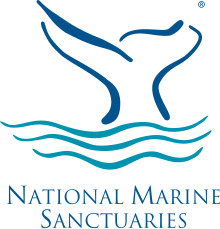National Marine Sanctuary
A National Marine Sanctuary is a US federally designated area in US waters that protects the marine environment with specific conservation, recreational, ecological, historical, cultural, archeological, scientific, educational, or aesthetic functions . The National Marine Sanctuary System temporarily consisted of 14 marine sanctuaries covering 388,498 km². Today there are still 13 national marine sanctuaries managed by the National Marine Sanctuaries Program (NMSP), a division of the National Oceanic and Atmospheric Administration (NOAA).
The Northwestern Hawaiian Islands National Marine National Sanctuary was founded as a bird sanctuary in 1909, rededicated as a National Marine Sanctuary in 2000 and significantly expanded in 2006 and designated as a National Monument- type Papahānaumokuākea Marine National Monument .
The program began after the 1969 Santa Barbara oil spill on the California coast , which created a state of emergency in marine ecosystems on a national scale. The United States Congress responded in 1972 with the Marine Protection, Research, and Sanctuaries Act , which allowed the creation of marine protected areas. The resources protected by the sanctuaries range from coral reef ecosystems in Florida, Hawaii and Samoa to shipwrecks in Lake Huron and the wreck of the USS Monitor .
List of National Marine Sanctuaries
- Channel Islands National Marine Sanctuary ( Pacific )
- Cordell Bank National Marine Sanctuary (Pacific)
- Fagatele Bay National Marine Sanctuary (Pacific)
- Florida Keys National Marine Sanctuary ( Atlantic Ocean , Gulf Coast )
- Flower Garden National Marine Sanctuary (Gulf Coast)
- Gray's Reef National Marine Sanctuary (Atlantic Ocean)
- Gulf of the Farallones National Marine Sanctuary (Pacific)
- Hawaiian Islands Humpback Whale National Marine Sanctuary (Pacific)
- Monitor National Marine Sanctuary (Atlantic)
- Monterey Bay National Marine Sanctuary (Pacific)
- Olympic Coast National Marine Sanctuary (Pacific)
- Stellwagen Bank National Marine Sanctuary (Atlantic)
- Thunder Bay National Marine Sanctuary ( Great Lakes )

